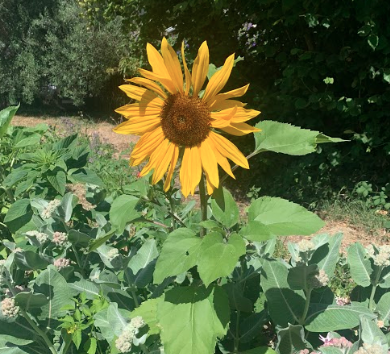
- Garden Fork
- Garden Rake
- Cultivation: the process of working the top sections of soil to maintain soil fertility to grow plants.
- Tillage: Digging deep into the soil to break it up. 4-6 inches is considered shallow tillage while 8-10 inches is deep tillage. Sometimes referred to as deep cultivation.
- Photosynthesis: The process by which plants and some other microorganisms use sunlight to create their own food from carbon dioxide (CO2) and water (H2O).
- Aeration: The process of decreasing the density of a substance (such as soil) and integrating more oxygen into it.
- Compost: decayed organic material (such as dead plants and food scraps) often used as fertilizer for plants.
- Fertilizer: a natural or chemical substance often added to soil to increase its nutrient-content.
- This lesson involves setting up an investigation comparing the effect of tilling and cultivating on crop health. Students will plant starts in both cultivated and uncultivated soil, and then track their observations over the weeks that follow. There will be opportunities built-in to subsequent lessons for students to make note of their observations.
- Take some time to read the definitions of the key terms we will be learning today to familiarize yourself or the class with keywords that will be covered in the lesson.
- The “READ” sections of this lesson plan can be used as talking points or a script to introduce activities. Please note, these sections simply provide brief introductions to the topics. We recommend using your experiences to add more information and context to the topics being covered.
- If teaching asynchronously or assigning the lesson plan as homework, for the sections that instruct students to READ, consider recording you reading the sections aloud and sending the recording to students. This adaptation offers a helpful strategy for differentiating learning that supports all students.
- The “THINK or DISCUSS” sections of the activities provide some great prompts for informal conversations. Consider asking your students these questions as they are gardening. You could also create a “question board” with the different questions and have students informally choose different questions to answer while they garden.
- Optional—as an added activity you could create a public space where students can share the things they notice during each of the rotations. This could take the form of a board with chart paper or markers where students can write down their answers to the questions labeled “NOTICE.” This extra activity supports students to glean observations from their classmates and learn from one another.
- For more information on the practices of organic farming, see the Center for Agroecology and Sustainable Food Systems curriculum on Organic Farming and Gardening Skills.
- This lesson begins by asking students to develop descriptions of the processes of tilling and cultivating through observing the practices in action. This prompt is designed to support students in continuing to develop the skill of close observation—a critical skill in science.
-
You may choose to deepen the layers of investigation in this lesson by adding compost to some of the starts and not others. Students will be investigating compost at the end of this unit, and starting the investigation now will allow them to gather data on the impact of compost on crop health by the time you get to the compost lesson. If you do choose to do this, you should have four distinct sections of plant starts: uncultivated soil without compost, uncultivated soil with compost, cultivated soil without compost, and cultivated soil with compost.
- Garden Cultivation and Tillage (2015). In Brown, M.; Miles. A. & Perez. J. (Eds.) Teaching Organic Farming and Gardening (pp. 31-95). Retrieved from https://casfs.ucsc.edu/about/publications/Teaching-Organic-Farming/PDF-d... tillage.pdf
- Estimating soil moisture by feel and appearances (n.d). United States Department of Agriculture. Retrieved from https://www.wcc.nrcs.usda.gov/ftpref/wntsc/waterMgt/irrigation/Estimatin...
- Evaluating soil moisture before field preparation and planting (n.d). Iowa State University Extension. Retrieved from https://crops.extension.iastate.edu/encyclopedia/evaluating-soil-moistur... preparation-and-planting
Disclaimer: All references and videos are used for educational purposes only. The Edible Schoolyard Project does not endorse any brands, labels, organizations, or businesses included in references or videos.




